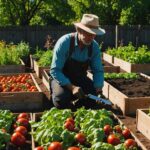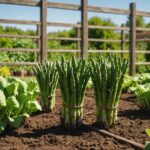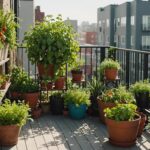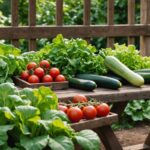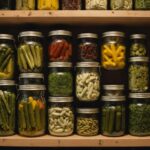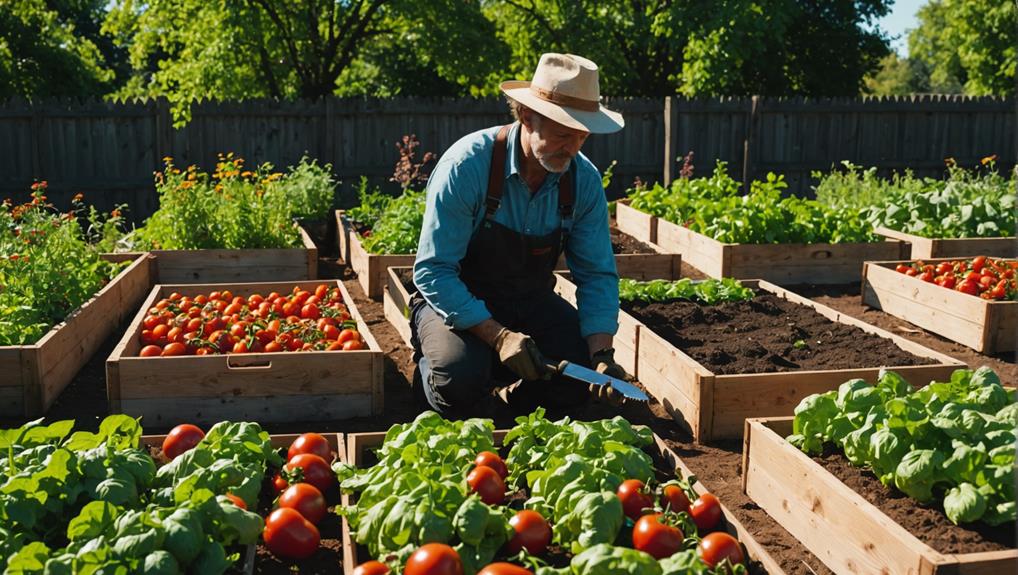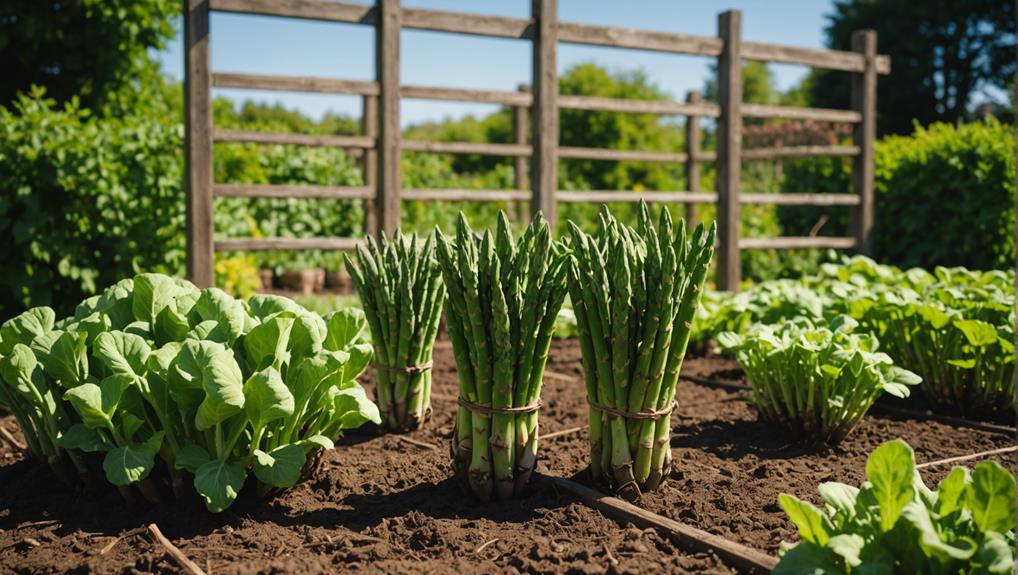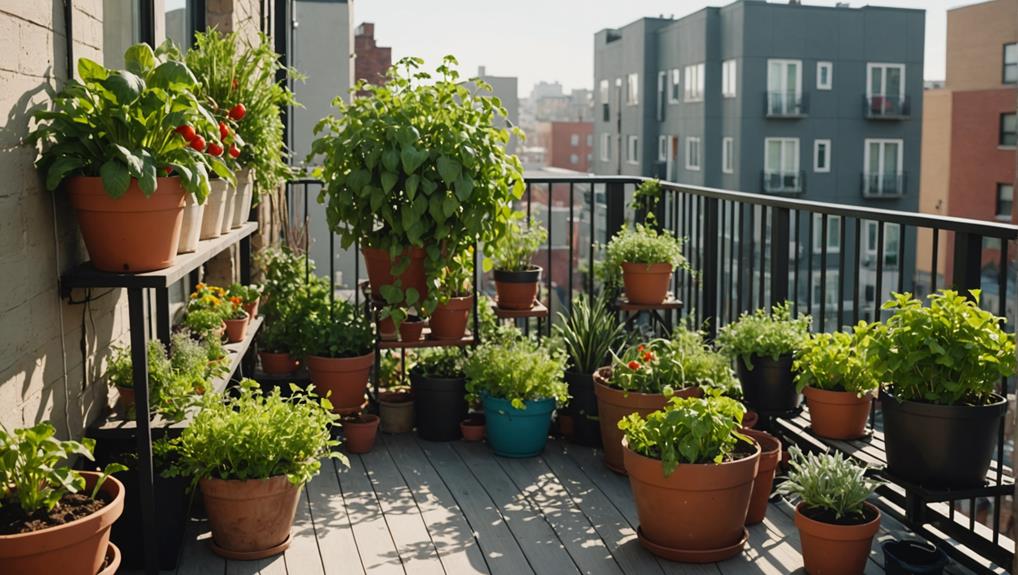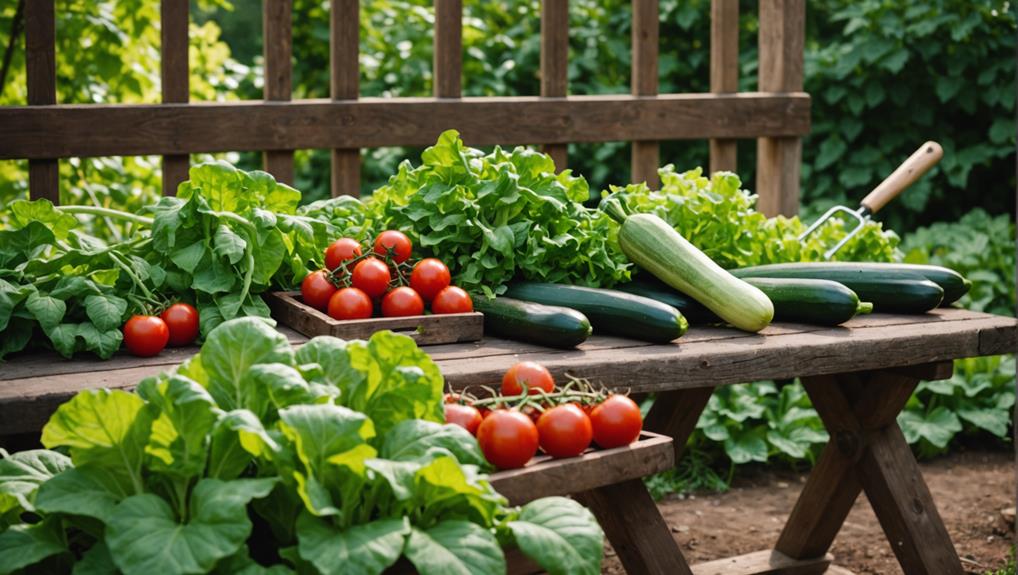As an Amazon Associate I earn from qualifying purchases.
If you want to grow your own food supply as a prepper, start by choosing a sunny spot with good soil. Test the soil and amend it for nutrients. Select high-calorie crops like potatoes and beans, and consider heirloom seeds for sustainability. Use companion planting to boost growth and lessen pests. Regularly water your garden and practice crop rotation to maintain soil health. Keep an eye on your progress with a gardening journal. By following these tips, you can create a resilient garden that supports your food needs. There’s plenty more to uncover that could enhance your gardening journey.
Importance of a Survival Garden
A survival garden isn’t just a luxury; it’s your key to self-reliance and food security during tough times. By growing food, you take control of your nourishment, ensuring access to fresh produce when supermarket shelves may be bare. These gardens are essential for enhancing your diet with crops that pack important nutrients, like Vitamin C-rich cherry tomatoes and leafy greens, which are critical for maintaining health during crises.
Not only does establishing a survival garden boost your nutritional value, but it also alleviates financial burdens. You’ll see significant savings on grocery bills as homegrown vegetables often cost less than store-bought options. This financial freedom is empowering and enables you to redirect your resources toward other important areas of your life.
Moreover, the rise of survival gardening among millions of Americans highlights the importance of community resilience. When individuals grow their own food, they build a stronger network that can withstand unpredictable food supply chains. Embracing a survival garden means supporting not just your well-being, but also fostering a resilient community that thrives even in the face of adversity. Start growing today, and secure your future!
Choosing the Right Location
Choosing the right location for your survival garden can make all the difference in your crops’ success and your overall gardening experience. Start by finding a spot that gets at least 6-8 hours of direct sunlight daily. Sunlight is essential for healthy growth and maximizing yield. Next, consider your water access; it’s best to choose a location within 50 feet of a reliable water source for easy irrigation and maintenance.
Keep these points in mind as you scout for the perfect spot:
- Assess soil quality: Conduct a soil test to determine pH levels and nutrient composition. Healthy soil means robust crops.
- Evaluate environmental factors: Look for areas that offer protection from harsh winds and flooding while ensuring proper drainage.
Soil Preparation Essentials
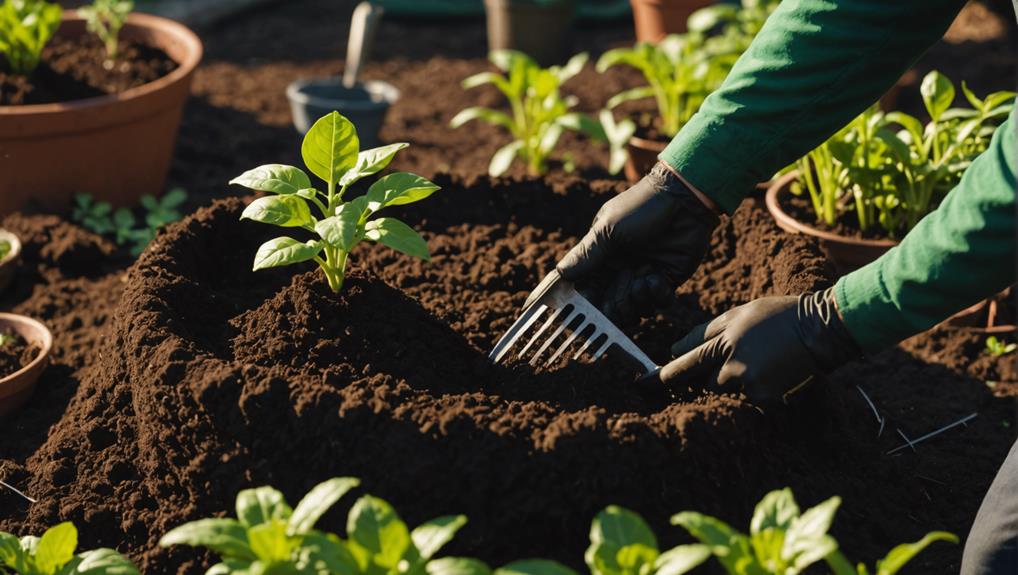
To grow a successful garden, you need to start with quality soil. Conducting a soil test helps you understand the nutrient levels and pH, setting you up for better crop yields. By incorporating organic amendments, you’ll enhance the soil’s fertility and structure, giving your plants the best chance to thrive.
Soil Testing Importance
Understanding your soil through testing is essential for guaranteeing ideal plant growth and a successful garden. Soil testing reveals critical information about your soil’s nutrient composition, including pH levels, macronutrients, and micronutrients. By knowing these details, you can implement targeted fertilization strategies that enhance soil health and maximize your garden’s potential.
Consider these key benefits of soil testing:
- Optimal Nutrient Management: Identify deficiencies in macronutrients like nitrogen, phosphorus, and potassium, as well as micronutrients such as iron and zinc.
- Improved Water Retention and Drainage: Understand your soil texture, which influences how well your garden holds water and drains excess moisture.
Organic Amendments Benefits
Organic amendments greatly boost soil fertility and structure, ensuring your garden thrives with robust plant growth and abundant yields. By incorporating organic matter, you enhance nutrient levels and promote healthy root growth, which are essential for your plants’ success.
Here’s a quick comparison of popular organic amendments:
| Organic Amendment | Benefits | Usage Tips |
|---|---|---|
| Compost | Increases soil fertility | Mix into the topsoil |
| Kelp Meal | Boosts plant growth | Apply during planting |
| Neem Cake | Protects against pests | Incorporate into the soil |
Using these organic amendments improves moisture retention, drainage, and aeration—key factors for sustaining healthy plant growth. For example, compost not only enriches the soil but also aids in moisture retention, while kelp meal stimulates growth with its natural hormones. Regularly applying these amendments can lead to increased crop yields, allowing you to secure your food supply and embrace the freedom of self-sustainability. So, roll up your sleeves, and get ready to enrich your soil for a more fruitful garden!
Maximizing Crop Yield Techniques
Maximizing crop yield involves a combination of strategic planting techniques and soil management practices that boost productivity in any garden. By implementing these methods, you can guarantee a robust food supply for your needs.
- Companion planting: Pairing plants like tomatoes and basil can deter pests and enhance growth.
- Succession planting: Replace harvested crops with new seeds to produce throughout the growing season, guaranteeing a continuous harvest.
Utilizing container gardening is also a smart way to achieve space utilization, especially if you have limited room. Focus on low-volume crops that thrive in smaller areas, allowing you to diversify your garden without feeling constrained. This approach not only enhances crop productivity but also fosters a sense of freedom in your gardening efforts. Remember, the more you prioritize these techniques, the higher your crop yield will be, empowering you to grow your own food supply efficiently. Embrace these strategies, and watch your garden flourish!
Plant Selection Best Practices

Choosing the right crops is essential for creating a thriving survival garden that meets your nutritional needs and adapts to your local environment. Focus on high-calorie and nutrient-dense options like potatoes, beans, and leafy greens. These crops provide energy and essential nutrients, ensuring you stay healthy and strong.
Opt for heirloom and open-pollinated survival garden seeds. They’re not just great for seed saving; they also offer a diverse range of varieties that thrive in your local climate. Assess your growing conditions and choose crops suited to your USDA hardiness zone. This will boost your yields and resilience against environmental stressors.
Utilize companion planting techniques by pairing crops like tomatoes with basil or corn with beans. This method can enhance growth, deter pests, and maximize space efficiency in your garden. Don’t forget about crop rotation—this practice helps maintain soil health and prevents pests and diseases.
Maintenance and Sustainability Tips
Maintaining a healthy and sustainable garden requires regular soil testing to guarantee your plants get the nutrients they need to thrive. By identifying nutrient deficiencies early, you can effectively use organic amendments like compost and worm castings to boost soil fertility.
To keep your garden thriving, consider these essential practices:
- Implement crop rotation to prevent nutrient depletion and reduce pest buildup.
- Mulch consistently with organic materials to retain moisture, suppress weeds, and enrich soil structure.
Keeping a gardening journal is vital. It helps you track planting dates, crop yields, and maintenance practices, allowing you to learn from both successes and failures. By documenting your journey, you’ll foster continuous improvement in your gardening efforts. Remember, sustainable productivity is about harmonizing your methods with the environment. With these maintenance practices, you’ll not only enjoy freedom from dependency but also cultivate a resilient food supply that empowers you and your family. So explore, stay committed, and reap the rewards of your hard work!
Resources for Successful Gardening
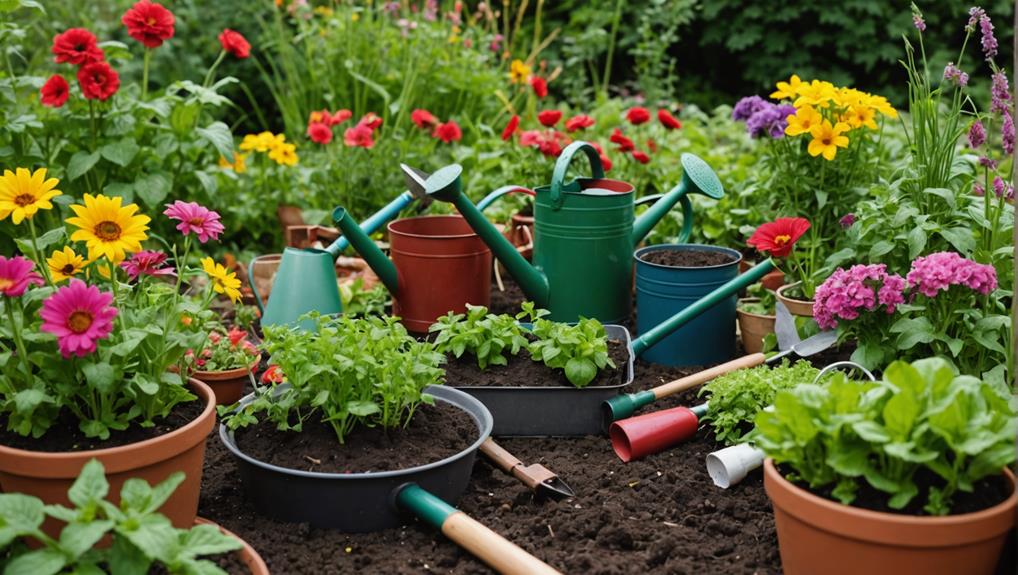
To have a thriving garden, you’ll need the right tools and resources at your fingertips. Start by exploring effective seed sourcing strategies to guarantee you have a diverse selection for planting. Additionally, tapping into reliable gardening resources can greatly enhance your skills and confidence as you cultivate your prepper garden.
Essential Gardening Tools
Having the right gardening tools can make a significant difference in your success as a prepper, ensuring efficient soil preparation, planting, and harvesting. Investing in essential gardening tools not only saves you time but also helps you cultivate a thriving food supply. Here’s a quick list of must-haves:
- Shovel: For digging and turning soil, essential for creating beds and planting.
- Hoe: Perfect for cultivating and weeding, keeping your garden healthy.
Beyond these basics, consider adding soil testing kits to assess your soil’s health, ensuring you know what amendments to add. Watering equipment, like drip irrigation, can help you conserve water while keeping your plants hydrated. Composting bins allow you to recycle waste into nutrient-rich compost, enhancing your soil’s quality. Finally, use seed storage containers to keep your heirloom and non-GMO seeds viable for future planting.
Seed Sourcing Strategies
Sourcing the right seeds is essential for building a resilient and productive garden, so consider heirloom and non-GMO varieties to guarantee sustainability and self-sufficiency. You might want to invest in a Vegetable Seed Vault Kit, which offers over 16,000 seeds, including 35 easy-to-grow vegetable types. This can help you establish a diverse garden that thrives in your local climate.
Engaging in community gardening and local seed exchanges can also enhance your options. By connecting with like-minded individuals, you’ll gain access to rare and region-specific seeds while sharing valuable knowledge. Research reputable online suppliers specializing in organic varieties to ascertain your seeds are adapted to your growing conditions.
Utilizing companion planting strategies is another effective method to enhance garden productivity and pest control. Here’s a handy table to help you visualize your seed sourcing options:
| Seed Type | Benefits |
|---|---|
| Heirloom Seeds | Sustainability, seed saving |
| Non-GMO Seeds | Chemical-free, natural growth |
| Vegetable Seed Vault Kit | Diverse options, easy-to-grow |
| Community Gardening | Knowledge sharing, local support |
| Seed Exchanges | Rare varieties, community ties |
Reliable Gardening Resources
Explore a variety of reliable gardening resources to boost your skills and secure a thriving, sustainable garden. As a gardening enthusiast, you want to ascertain your food supply is resilient and plentiful. Here are some essential resources to take into account:
- Comprehensive Books: Immerse yourself in titles like ‘Grow or Die’ by David the Good for practical survival gardening techniques.
- Online Communities: Engage with forums and social media groups where experienced gardeners share invaluable tips and success stories.
You’ll also benefit from educational videos on platforms like YouTube, which offer visual guidance on vital techniques such as composting and pest management. Joining local gardening clubs can foster collaboration and knowledge sharing, enhancing your survival and sustainable living practices.
Frequently Asked Questions
How Do I Start Growing My Own Food?
To start growing your own food, assess your space for container gardening, select heirloom seeds, test your soil, plan seasonal planting, use composting techniques, and implement pest management and crop rotation for a thriving garden.
How Much Food Do I Need to Grow to Be Self Sufficient?
To meet your self-sufficiency goals, consider yield estimates based on seasonal planting, crop rotation, and companion planting. Focus on soil health and pest control, while preserving your harvest using sustainable practices for long-term success.
How Can I Save Money by Growing My Own Food?
You can save money by embracing budget gardening through seed saving, composting techniques, and container gardening. Implement crop rotation, seasonal planting, and vertical farming while using organic fertilizers and effective pest control for efficient meal planning.
How Much Land Do You Need to Grow Your Own Food?
You’ll need varying land requirements based on your goals. Urban gardening, like container gardening or vertical farming, can maximize space. Focus on soil quality, seasonal planting, and permaculture principles for efficient food production and community gardens.
Conclusion
By starting your survival garden, you’re taking an essential step towards self-sufficiency and resilience. With the right location, well-prepared soil, and careful plant selection, you can maximize your crop yield and guarantee a reliable food supply. Remember to maintain your garden sustainably to keep it thriving. Embrace the journey of growing your own food, and you’ll not only secure your future but also enjoy the rewards of your hard work. Happy gardening!
As an Amazon Associate I earn from qualifying purchases.
